In the vast folklore stratum of non-professional icon painting in Russia, icons by simple rural craftsmen, called bogomazi or God-painters, stand out. They were engaged in the icon-painting but also “daubed” everything to please their soul - paintings of flowers, birds, the interiors of rural houses, and even decorated furniture. They loved the Savior, his Mother the Divine, and the most revered Russian Saints: St. Nicholas the Wonderworker, St. George the Victorious, Paraskeva the Friday, Elijah the Prophet, Alexander Nevsky, and all others, and therefore depicted them as they could. In many places in the distant lands of Russia, there was no other kind of icons available - either they were kept within the closed walls of the monasteries or they were too expensive for the ordinary people. Today, the provincial icons are studied not only as a distinct variety of the Orthodox iconography but also as examples of Russian folk art.
Russian Icon - Coronation of the Virgin Mary, Mother of God
The icon is depicting the Virgin Mary in Heaven being crowned by Christ and God the Father with a dove above them comprisit the New Testament Trinity.
- ID# 262-105-108-SP6-28
- Size 19 x 20 in (48 x 51 cm)
- Age ca. 1880's
- Materials Egg tempera and gilding on gessoed wood
- Price $2,500
-

Russian icon - Christ Enthroned with St Nicholas & St John the Baptist
This large icon depicts the Savior Enthroned flanked by St Nicholas of Myra and St John the Baptist.
- ID# 35-051-117-SP7-4
- Size 17 1/3 x 26 in (44 x 66 cm)
- Age ca. 1890s
- Materials Oil on gessoed wood
- Price $2,750
-

Russian Icon depicting Saint Michael the Archangel and Holy Monastic Martyr Saint Eudokia of Heliopolis
The Holy Archangel Michael is one of the most celebrated of the Angels and bodiless powers; he is called the Archistrategos, or chief commander, of all the bodiless powers. According to Holy Scripture and Tradition, he has interceded for humanity multiple times and continues to serve as the Defender of the Faith. Saint Michael is most often invoked for protection from invasion by enemies and from civil war, and for the defeat of adversaries on the field of battle.
Saint Eudokia was a Samarian woman who lived in Heliopolis of Phoenicia (present day Baalbek, Lebanon). She was a very beautiful pagan, and garnered her wealth by attracting wealthy lovers.
Eudokia learned about Christianity from a monk by the name of Germanos and asked him if she, too, could be saved from Judgment. Germanos instructed her to remain alone in her chamber for one week, fasting and praying. Eudokia followed his instructions, and at the end of the week, she had a vision about the Archangel Michael that assured her of Christ's love for all people. At age 30, Eudokia commissioned the building of a monastery near Heliopolis, and dispensed much of her wealth in various charitable projects. She rejected all of her suitors, and when one persistent suitor named Philostratos was struck down because of his persistence, Eudokia prayed for him until he recovered and then converted to Christianity. Eudokia persuaded many pagans to convert to Christianity and, by her actions, angered Roman officials who had her beheaded on in 107 AD.
- ID# 76-016-082-L60i4-150
- Size 15 in x 11 3/4 in (38 cm x 30 cm)
- Age ca. 1870, Provincial
- Materials Oil on gessoed wood
- Price $1,200
Russian Icon - The Dormition of the Virgin Mary, St. George and 7 Selected Saints
The icon is depicting seven selected Orthodox Saints: St. Andrew the Apostle, St. Qeen Helena, St. Nicholas of Myra, St. Maria, St. Stephen the Protomartyr, St. John the Theologian and St. Paraskevi the Friday surmounted by vignette images depicting the Dormition of the Most Holy Mother of God and Miracle of St George Slaying the Dragon.
- ID# 166-027-069-SP7-7
- Size 13 3/4 x 11 3/4 in (35 x 30 cm)
- Age ca. 1890s
- Materials Egg tempera on gessoed wood
- Price $1,200
-

-

Russian Church Icon - The Protection of the Most Holy Mother of God
The Protection (Pokrov) of the Most Holy Mother of God is one of the most beloved Feast days on the Orthodox calendar commemorated on October 1 celebrating the appearance of the Virgin Mary in Constantinople in the 10th century at the time when the people in the city were threatened by the Barbarian invasion. Saint Andrew, the Holy Fool with his disciple Saint Epiphanius, and a group of people, saw the Mother of God, Saint John the Baptist, and several other Saints and Angels during a vigil in the Church of Blachernae, nearby the city gates. The Mother of God approached the center of the church, knelt down and remained in prayer for a long time with her face drowned in tears. Then she took her veil off and spread it over the people as a sign of protection. After the appearance of the Mother of God, the danger was averted and the city was spared from bloodshed and suffering.
On the icon, the Theotokos is depicted standing in Orans position, holding her veil in outstretched arms, flanked by blessing Christ and St John the Baptist. Below are Saint Romanos the Melodist, Saint Epiphanius and Saint Andrew the Fool, St Emperor Constantine and his mother St Helena.
- ID# 255-105-103-SP7-28
- Size 21 3/4 x 15 3/4 in (55 x 40 cm)
- Age ca. 1900
- Materials Oil on gessoed wood
- Price $1,200
-

Russian Icon - Our Lady of Iveron
Our Lady of Iveron is the Eastern Orthodox icon of Virgin Mary which, according to the Sacred Tradition, was painted by Luke the Evangelist. The icon is referred to as "Wonderworking" meaning that numerous miracles have been attributed to the intercession of the Theotokos by persons praying before it. The original of this image is found in the Georgian Iveron monastery on Mount Athos in Greece, where it is believed to have been since the year 999.
- ID# 228-096-039-SP6-115
- Size 15 3/4 x 11 in (40 x 28 cm)
- Age ca. 1890's
- Materials Egg tempera on gessoed wood
- Price $1,000
-

Russian Icon - Miracle of St George Slaying the Dragon
The Great Martyr Saint George is depicted as a mounted soldier striking with a lance a dragon beneath his horse. On the right is the town of Silene with a princess Elisaba, whose fate is in George’s hands, standing at the gate. The scene is titled in Old Slavonic as "Saint George the Victorybearer." The oldest icons depicting Saint George as a horseman killing the dragon date to the 12th century. The motif becomes popular especially in Georgian and Russian tradition, but it is also found in Greek icons.
- ID# 76-103-054-SP7-15
- Size 16 1/2 x 12 1/2 in (42 x 32 cm)
- Age ca. 1890s
- Materials Egg tempera on gessoed wood
- Price $975
-

Russian Icon - Orthodox Saints: St John Martyr, St Peter Mitropolitain & St Olga Princess
The icon is depictiung three Orthodox saints pictured frontally full-figured: St Peter Mitropolitain of Moscow, flanked by St John Martyr and St Olga Princess.
- ID# 112-104-077-SP7-1
- Size 13 3/4 x 11 3/4 in (35 x 30 cm)
- Age ca. 1900
- Materials Oil on gessoed wood
- Price $975
-

Russian Icon - Our Lady of Vladimir
Our Lady of Vladimir is one of the most highly venerated Orthodox icons and a typical example of Byzantine iconography. The original 12th century icon survived and is displayed in the Tretyakov Gallery museum in Moscow. Even more than most famous icons, the original has been copied repeatedly for centuries and many copies now have considerable artistic and religious significance of their own. The icon is a version of the Eleusa (Tenderness) type, with the Christ child snuggling up to his mother's cheek. The venerated image was used in celebration of coronations of Tsars, elections of Patriarchs, and other important ceremonies of the Russian state. Her feast day is June 3.
- ID# 182-028-053-SP6-11
- Size 14 1/2 x 11 3/4 in (37 x 35 cm)
- Age ca. 1900
- Materials Egg tempera on gessoed wood
- Price $950
-

Russian Icon - Miracle of St. George Slaying the Dragon
The Great Martyr Saint George is depicted as a mounted soldier striking with a lance a dragon beneath his horse. On the right is the town of Silene with a princess Elisaba, whose fate is in George’s hands, standing at the gate. The scene is titled in Old Slavonic as "Saint George the Victorybearer." The oldest icons depicting Saint George as a horseman killing the dragon date to the 12th century. The motif becomes popular especially in Georgian and Russian tradition, but it is also found in Greek icons.
- ID# 88-43-89-SP6-9
- Size 12 x 10 in (31 x 26 cm)
- Age ca. 1900
- Materials Egg tempera and gilding on gessoed wood
- Price $900
-

Russian Icon - Christ Pantocrator
Christ Pantocrator refers to a specific depiction of Christ. The most common translation of Pantocrator is "Almighty" or "All-powerful". In this understanding, Pantocrator is a compound word formed from the Greek words for "all" and the noun "strength" (κρατος). This is often understood in terms of potential power; i.e., ability to do anything, omnipotence. The iconic image of Christ Pantocrator was one of the first images of Christ developed in the Early Christian Church and remains a central icon of the Eastern Orthodox Church. In the half-length image, Christ holds the Gospels in his left hand and makes the gesture of blessing with his right. The Gospels are opened on Matthew 11:28 “Come unto me, all ye that labour and are heavy laden, and I will give you rest.”
- ID# 246-102-059-SP6-1
- Size 17 3/4 x 13 3/4 in (45 x 35 cm)
- Age ca. 1900
- Materials Oil on gessoed wood
- Price $900
-

Russian icon - St. Nicholas the Wonderworker of Myra
Saint Nicholas of Myra ( Άγιος Νικόλαος, Николай Чудотворец) (270 - 343), was a historic 4th-century Saint and Greek Bishop of Myra. Because of the many miracles attributed to his intercession, he is also known as Nicholas the Wonderworker. He had a reputation for secret gift-giving, such as putting coins in the shoes of those who left them out for him, and thus became the model for Santa Claus. His reputation evolved among the faithful, as was common for early Christian saints.
- ID# 43-074-104-SP7-35
- Size 20 x 22 3/4 in (51 x 58 cm)
- Age ca. 1910s
- Materials Oil on gessoed wood
- Price $900
-

-

Russian Icon - Christ Pantocrator
The icon depicts realistically rendered Christ as Pantocrator ( "Almighty" or "All-powerful") - pictured half-figured blessing with his right hand while holding an Orb and a Cross in his left hand
- ID# 189-052-075-SP6-1
- Size 12 1/2 x 10 1/2 in (32 x 27 cm)
- Age ca. 1900
- Materials Oil on gessoed wood
- Price $850
-

Three Orthodox Saints: Sts. Empress Alexandra Martyr, Blessed Maria, and Prince Mikhail
Icon depicts three Orthodox saints painted full figured - Saint Empress Martyr Alexandra of Rome , Blessed Maria, and Russian Prince Mikhail of Tver.
- ID# 107-042-002-SP6-1
- Size 12 1/4 x 10 1/4 in (31 x 26 cm)
- Age ca. 1900
- Materials Oil on gessoed wood
- Price $850
-

Russian Icon - Our Lady of the Sign
Our Lady of the Sign is one of the most beloved Russian miracleworking icons of Theotokos. The icon depicts the her during the Annunciation at the moment of saying, "May it be done to me according to your word." (Luke 1:38). The Virgin Mary is depicted frontally half-length, with her hands raised in praying position and the Child Jesus within a round aureole upon her breast representing him at the moment of his conception. The term Virgin of the Sign is a reference to the prophecy of Isaiah 7:14: "Therefore the Lord himself shall give you a sign; Behold, a virgin shall conceive, and bear a son, and shall call his name Immanuel."
- ID# 110-104-063-SP7-1
- Size 13 1/2 x 11 in (34 x 28 cm)
- Age ca. 1890s
- Materials Oil on gessoed wood
- Price $800
-

Russian Icon - 5 Selected Saints: Zosima, Barbara, Basil the Great, Claudia & Emperor Constantine
The icon is depicting five selected saints: St. Venerable Zosima, St. Barbara the Greatmartyress, St. Basil of Caesarea (the Great), St. Claudia Martyress of Rome, and Emperor Constantine. The saints are depicted full-figured standing frontally under the images of the blessing Christ in Heavens.
- ID# 162-024-138-RSSP-1
- Size 13 x 10 in (33 x 25 cm)
- Age ca. 1900
- Origin Provincial Russia
- Materials Oil on gessoed wood
- Price $800
-

-

Russian icon - 2 Saints: St. Alexandra of Rome & St. Venerable John Climacus
Saint Alexandra of Rome is a Christian martyr and saint, known from "Martyrdom of Saint George" as either Emperor Diocletian's wife or the wife of Dacian, a Roman Prefect. While Saint George was being tortured, Alexandra went to the arena, bowed before him and professed her faith openly. When she questioned whether she was worthy of paradise and of martyrdom without being baptized, Saint George told her, “Do not fear, for your blood will baptize you.” She was denounced a Christian and imprisoned on her husband’s orders in Nicomedia, then sentenced to death.
Saint Venerable John Climacus, also known as John of the Ladder, John Scholasticus and John Sinaites, was a 6th–7th-century Christian monk at the monastery on Mount Sinai revered as a saint by the Eastern Orthodox Church and Roman Catholic Church. "The Ladder of Divine Ascent", composed by John in the early seventh century, describes how to raise one's soul and body to God by acquiring ascetic virtues and became one of the most widely read and much-beloved books of Byzantine spirituality. Climacus uses the analogy of Jacob's Ladder as the framework for his spiritual teaching. Each chapter is called a "step" and deals with a separate spiritual subject. There are thirty Steps of the ladder, which correspond to the age of Jesus at his baptism and the beginning of his earthly ministry. This book is one of the most widely read among Orthodox Christians, especially during the season of Great Lent, which immediately precedes Pascha (Easter). It is often read in the trapeza (refectory) in Orthodox monasteries, and in some places, it is read in church as part of the Daily Office on Lenten weekdays, being prescribed in the Triodion.
- ID# 726-028-109-SP2
- Size 12 1/4 x 10 1/4 inches (31 x 26 cm)
- Age ca. 1880s
- Origin Provincial Russia
- Materials Egg tempera on parcel gilt and gessoed wood
- Price $775
-

Russian Icon - St Prophet Elijah
Saint Elijah was a prophet in the northern kingdom of Israel during the reign of Ahab (9th century BC). According to the Books of Kings, Elijah defended the worship of Yahweh over that of the Phoenician god Baal, he raised the dead, brought fire down from the sky, and was taken up in a whirlwind. In the Book of Malachi, Elijah's return is prophesied "before the coming of the great and terrible day of the Lord," making him a harbinger of the Messiah.
- ID# 13-102-107-SP7-15
- Size 11 3/4 x 10 1/2 in (30 x 27 cm)
- Age ca. 1870s
- Materials Oil on gessoed wood
- Price $750
-

Russian icon - St. Nicholas of Mozhaisk
In Russia, Saint Nicholas the Wonderworker is often shown as Holy Hierarch Nicholas of Mozhaisk, depicting a full-length Nicholas with a sword in his right hand and a city in his left because the prayers to Saint Nicholas saved the city of Mozhaisk from the enemy attack.
- ID# 39-068-037-SP7-5
- Size 14 1/2 x 12 1/4 in (37 x 31 cm)
- Age ca. 1890s
- Materials Egg tempera on gessoed wood under a silvered brass oklad
- Price $750
-

Russian icon - the Archangel Gabriel from the Annunciation
Left panel from a matching pair of icons originally inserted into the Royal Doors of an Orthodox iconostasis and depicting the Annunciation to the Blessed Virgin Mary, the Christian celebration of the announcement by the angel Gabriel to the Virgin Mary that she would conceive and become the mother of Jesus, the Son of God, marking his Incarnation. Gabriel is shown blessing with one hand and holding a stem of lilies in the other.
- ID# 47-103-079-SP7-1
- Size 10 1/2 x 8 3/4 in (27 x 22 cm)
- Age ca. 1850
- Materials Oil on gessoed wood
- Price $750
-

Russian Icon - Our Lady of the Unburnt Thornbush
The icon depicting the Miracleworking Madonna of Unburnt Thornbush has a unique iconography. The Virgin Mary with her Christ child holds the central position in this rose-shaped form that is like a Jungian mandala. The points of the eight-pointed “slava” (“Glory”) represent divine light and the Eighth day of Creation, the Day of Eternity. Eight angels in the “petals” of the rose represent the forces behind the elements of nature, the hidden powers that control the weather and relate also to the apocalyptic end of the world. The "Unburned Thornbush" icon was commonly venerated throughout Russia as a form of fire protection. It was used not only to ward off fire from a home but was also held up to stop a fire once it had begun.
- ID# 69-103-007-SP7-7
- Size 13 x 10 in (33 x 25 cm)
- Age ca. 1900
- Materials Egg tempera on gessoed wood
- Price $750
-

Russian Icon - Our Lady of Iveron
Our Lady of Iveron is the Eastern Orthodox icon of Virgin Mary which, according to the Sacred Tradition, was painted by Luke the Evangelist. The icon is referred to as "Wonderworking" meaning that numerous miracles have been attributed to the intercession of the Theotokos by persons praying before it. The original of this image is found in the Georgian Iveron monastery on Mount Athos in Greece, where it is believed to have been since the year 999.
- ID# 72-103-023-SP7-15
- Size 13 3/4 x 12 1/4 in (35 x 31 cm)
- Age ca. 1890s
- Materials Egg tempera on gessoed wood
- Price $750
-

Russian Icon - The Virgin Mary from the Deisis Row
- ID# 84-103-109-SP7-1
- Size 15 x 12 1/2 in (38 x 32 cm)
- Age ca. second half of the 19th century
- Origin Urals Mountains region
- Materials Egg tempera on gessoed wood
- Price $750
-

Russian Icon - St Martyress Justina & Joachim, father of the Virgin Mary
The icon is depicting St Martyress Justina of Antioch and St Joachim, the husband of Saint Anne and the father of Mary, the mother of Jesus.
- ID# 89-104-010-SP7-7
- Size 12 1/2 x 10 1/4 in (32 x 26 cm)
- Age ca. second half of the 19th century
- Origin Ural Mountains Region
- Materials Oil on gessoed wood
- Price $750
-

Russian Icon - Hodegetria Mother of God
The icon is depicting the Virgin Hodegetria, an iconographic depiction of the Theotokos (the Virgin Mary) holding the Child Jesus at her side while pointing to him as the source of salvation for humankind. The Virgin's head inclines towards the child, who raises his hand in a blessing gesture.
- ID# 230-098-106-SP7-2
- Size 18 1/2 x 15 1/2 in (47 x 39 cm)
- Age ca. 1890s
- Origin Provincial Russia
- Materials Egg tempera on gessoed wood
- Price $750
-

Russian Icon - Christ Pantocrator
The icon depicts Christ as Pantocrator ( "Almighty" or "All-powerful") - pictured half-figured blessing with his right hand while holding an Orb and a Cross in his left hand.
Christ Pantocrator refers to a specific depiction of Christ. The most common translation of Pantocrator is "Almighty" or "All-powerful". In this understanding, Pantocrator is a compound word formed from the Greek words for "all" and the noun "strength" (κρατος). This is often understood in terms of potential power; i.e., ability to do anything, omnipotence. The iconic image of Christ Pantocrator was one of the first images of Christ developed in the Early Christian Church and remains a central icon of the Eastern Orthodox Church.
- ID# 28-104-027-SP7-1
- Size 12 1/4 x 10 1/4 in (31 x 26 cm)
- Age ca. 1880's
- Materials Egg tempera on gessoed wood
- Price $725
-

Russian icon - Joy to All Who Sorrow Mother of God
Mother of God, Joy of All Who Sorrow of Moscow is the name of a popular wonderworking Russian Orthodox icon. The icon dates to a miracle that occurred on October 24, 1688, when a woman named Euphymia received healing from sickness after obeying a voice telling her to find this icon and have the priest celebrate a prayer with blessing of water. The design of this icon depicts the Mother of God, depicted full-figured standing with her Son in Heaven and God the Father above her in the clouds. Along both sides of the icon, framing the Mother of God, depicted are suppliants asking for her intercession assisted by angels. The tenderness and kindness of a loving mother are evident in her face as She stands in paradise and yet among us.
- ID# 36-064-024-SP7-1
- Size 10 1/3 x 8 3/4 in (26 x 22 cm)
- Age ca. 1880's
- Materials Oil on gessoed wood
- Price $725
-

Russian icon - 3 Orthodox Saints: St. John Climacus, St. Alexandra & St. Vassa
Saint Venerable John Climacus, also known as John of the Ladder, John Scholasticus and John Sinaites, was a 6th–7th-century Christian monk at the monastery on Mount Sinai revered as a saint by the Eastern Orthodox Church and Roman Catholic Church. "The Ladder of Divine Ascent", composed by John in the early seventh century, describes how to raise one's soul and body to God by acquiring ascetic virtues and became one of the most widely read and much-beloved books of Byzantine spirituality. Climacus uses the analogy of Jacob's Ladder as the framework for his spiritual teaching. Each chapter is called a "step" and deals with a separate spiritual subject. There are thirty Steps of the ladder, which correspond to the age of Jesus at his baptism and the beginning of his earthly ministry. This book is one of the most widely read among Orthodox Christians, especially during the season of Great Lent, which immediately precedes Pascha (Easter). It is often read in the trapeza (refectory) in Orthodox monasteries, and in some places, it is read in church as part of the Daily Office on Lenten weekdays, being prescribed in the Triodion.
Saint Alexandra of Rome is Christian martyr and saint, known from "Martyrdom of Saint George" as either Emperor Diocletian's wife or the wife of Dacian, a Roman Prefect. While Saint George was being tortured, Alexandra went to the arena, bowed before him and professed her faith openly. When she questioned whether she was worthy of paradise and of martyrdom without being baptized, Saint George told her “Do not fear, for your blood will baptize you.” She was denounced a Christian and imprisoned on her husband’s orders in Nicomedia, then sentenced to death.
Saint Vassa was a 4th-century Christian martyr from Edessa in Greek Macedonia who with her three young sons was tortured to death. She is venerated on August 21, by the Greek Orthodox Church and Serbian Orthodox Church.
- ID# 1085-044-021-SP2
- Size 10 1/2 x 9 inches (27 x 23 cm)
- Age ca. 1880s
- Origin Provincial Russia
- Materials Egg tempera on gessoed wood
- Price $725
-

Russian icon - Empress Alexandra Martyr of Rome & Alexander of Jerusalem, Martyrs & Saints
The icon depicts two full-figured Martyr Saints: Empress Alexandra of Rome and Alexander, Bishop of Jerusalem.
- ID# 181-027-328-SP6-8
- Size 10 1/4 x 8 3/4 in (26 x 22 cm)
- Age ca. 1890s
- Materials Egg tempera on gessoed wood
- Price $700
-

Russian icon - The Resurrection of Christ
The icon depicts of the Resurrection of Christ.
- ID# 186-047-016-SP6-8
- Size 10 1/4 x 8 3/4 in (26 x 21)
- Age ca. 1890s
- Materials Egg tempera on gessoed wood
- Price $700
-

Double-sided Russian Icon - Our Lady of Kazan / St Nicholas
Double-sided icon in original gilt frame. One side depicting Our Lady of Kazan and the other side - St. Nicholas of Myra.
- ID# 41-070-096-SP7-28
- Size 18 1/2 x 15 1/2 in (47 x 39 cm)
- Age ca. 1910s
- Materials Oil on gessoed wood
- Price $700
-

Russian Icon - Our Lady of Kazan
Our Lady of Kazan, is a holy icon of the highest stature within the Russian Orthodox Church and considered a palladium of Russia for centuries, until its theft and likely destruction in 1904. The icon represents the Virgin Mary as the protector and patroness of the city of Kazan. It is a close-up variant of the Hodegetria (Directress) style, it is noted mainly for the Child standing, with the Virgin chest-length. The Kazan icons are traditionally small, following the original. The Kazan icon was very popular in Russia, especially as a wedding gift, and many copies were made in the design of the original. Two major Kazan Cathedrals, in Moscow and St. Petersburg, are consecrated to Our Lady of Kazan, as are numerous churches throughout the land. Her feast days are July 21 and November 4.
A small figure on the left is St. Mary of Egypt.
Saint Mary of Egypt (ca. 344 – ca. 421) lived an extremely dissolute life but was struck with remorse, and upon seeing an icon of the Virgin Mary in Jerusalem gave up the world to become an ascetic. She is revered as the patron saint of penitents, most particularly in the Eastern Orthodox, Oriental Orthodox, and Eastern Catholic churches, as well as in the Roman Catholic and Anglican churches. Patronage: Chastity (warfare against the flesh; deliverance from carnal passions); deliverance from Demons; Fever; Skin diseases; Temptations of the flesh. Her feast day is commemorated by the Church on April 1.
- ID# 169-028-001-SP7-7
- Size 12 1/4 x 9 3/4 in (31 x 25 cm)
- Age ca. 1900
- Origin Provincial Russia
- Materials Oil on gessoed wood
- Price $700
-

Russian Icon - 3 Female Saints: St. Pelagia of Antioch, St. Tais of Egypt & St. Martyress Mariana
The icon is depicting three full-figured female saints: St. Pelagia of Antioch & St. Tais of Egypt (two repentant saints sharing the same feast day of October 8), and St. Martyress Mariana.
- ID# 188-043-025-SP7-4
- Size 9 3/4 x 8 1/3 in (25 x 21 cm)
- Age ca. 1890
- Origin Provincial Russia
- Materials Egg tempera on gessoed wood
- Price $700
-

Russian icon - Our Lady of Kazan
Our Lady of Kazan is a holy icon of the highest stature within the Russian Orthodox Church and considered a palladium of Russia for centuries, until its theft and likely destruction in 1904. The icon represents the Virgin Mary as the protector and patroness of the city of Kazan. It is a close-up variant of the Hodegetria (Directress) style, it is noted mainly for the Child standing, with the Virgin chest-length. The Kazan icons are traditionally small, following the original. The Kazan icon was very popular in Russia, especially as a wedding gift, and many copies were made in the design of the original. Two major Kazan Cathedrals, in Moscow and St. Petersburg, are consecrated to Our Lady of Kazan, as are numerous churches throughout the land. Her feast days are July 21 and November 4.
- ID# 241-101-103-SP7-1
- Size 13 x 10 1/2 in (33 x 27 cm)
- Age ca. second half of the 19th century
- Origin Provincial Russia, Ural Mountains (?)
- Materials Oil on parcel gilt and gessoed wood
- Price $700
-

Russian Icon - Seeker for the Perished Mother of God
The miraculous icon of the Seeker of the Lost Mother of God (sometimes known as the Seeker of the Perished) became known in Russia in the 18th century and is attributed to its rescue from the damnation of a monk in Asia Minor. The name of the icon refers not only to those who are dying but to those whose souls are in danger of spiritual death. The Queen of Heaven sends down help and support for all: “Seek us who are perishing, O Most Holy Virgin, chasten us not according to our sins, but as you are merciful in your love for mankind, have pity, deliver us from hell, sickness and necessity, and save us” (Troparion, Tone 4).
- ID# 253-105-073-SP7-1
- Size 10 1/4 x 8 1/3 in (26 x 21 cm)
- Age ca. second quarter of the 19th century
- Origin Provincial Russia
- Materials Oil on gessoed wood
- Price $700
-

Russian icon - The Protection of the Most Holy Mother of God (Pokrov)
The Protection (Pokrov) of the Most Holy Mother of God is one of the most beloved Feast days on the Orthodox calendar commemorated on October 1 celebrating the appearance of the Virgin Mary in Constantinople in the 10th century at the time when the people in the city were threatened by the Barbarian invasion. Saint Andrew, the Holy Fool with his disciple Saint Epiphanius, and a group of people, saw the Mother of God, Saint John the Baptist, and several other Saints and Angels during a vigil in the Church of Blachernae, nearby the city gates. The Mother of God approached the center of the church, knelt down and remained in prayer for a long time with her face drowned in tears. Then she took her veil off and spread it over the people as a sign of protection. After the appearance of the Mother of God, the danger was averted and the city was spared from bloodshed and suffering.
The icon depicts Saint Romanos the Melodist, Saint Epiphanius and Saint Andrew the Fool with Saint Emperor Constantin and Empress Helena standing under the Mother of God in Heavens who is holding the Protective Veil over them.
- ID# 232-101-016-SP6-75
- Size 10 1/2 x 8 1/2 in (27 x 21 cm)
- Age ca. 1890s
- Origin Western Russia
- Materials Oil on gessoed wood
- Price $675
-

Russian Icon - Saint Martyrs Shamona, Guria & Abibus of Edessa (Samon, Gury & Aviv) - Patrons of the Holy Matrimony
Saints Shamona, Guria, and Deacon Abibus of Edessa (known in Russia as Samon, Gury, and Aviv) († ca. 322) were Christians who were martyred in Edessa, Mesopotamia under Emperor Licinius for refusal to worship the Pagan Gods. They are venerated in the Orthodox Church as Patron Saints of the Holy Matrimony and their Feast day is celebrated on November 15. The Orthodox icons depicting the Saints are traditionally gifted as a wedding present. Saint Samon is depicted as a middle-aged man with dark hair and a small beard with a cross in his hands; Saint Gury is depicted as a gray-haired elder with a long beard also holding a cross; Aviv as a young, beardless man in a deacon’s stole holding a censer.
- ID# 251-105-050-SP7-7
- Size 9 3/4 x 7 in (25 x 18 cm)
- Age ca. 1880s
- Origin Provincial Russia
- Materials Oil on gessoed wood
- Price $675
-

Russian icon - 5 Selected Saints: St. Matrona, St. Peter of Moscow, St. Ven. Basil, St. Prince Michael & St. Antony of Kiev
The icon depicts the following five selected Orthodox Saints: St. Martyress Matrona, St. Peter Metropolitan of Moscow, St. Venerable Basil the Confessor, Holy Right-Believing Martyr Prince Michael of Tver, and St. Venerable Antony of Kiev-Pechora Monastery.
- ID# 1179-014-059-SP2
- Size 10 1/4 x 8 1/4 inches (26 x 21 cm)
- Age ca. 1870s
- Origin Provincial Russia
- Materials Egg tempera on gessoed wood
- Price $675
-

Russian icon - St. Theodosius, Archbishop of Chernigov
Saint Theodosius, Archbishop of Chernigov (†1696) is venerated as a Hierarch of the Orthodox Church, and his relics were proclaimed to have healing powers. Among St. Theodosius’ remarkable qualities were his rigorous fairness in dealing with clergy and flock, his profound sympathy, his tolerance, and his Christian peaceable disposition. Not only Orthodox people but also people of other faiths turned to him for help and counsel. The canonization of Holy Hierarch Theodosius took place in 1896, and his feast days are commemorated September 9/22 and February 5/18.
- ID# 1349-009-317-SP2
- Size 10 1/2 x 8 1/2 inches (27 x 22 cm)
- Age ca. 1900
- Origin Provincial Russia
- Materials Egg tempera on gessoed wood
- Price $675
-

Russian icon - Two Orthodox Saints: Martyress Vera & Nicephorus (Nikifor) of Constantinople
Russian icon depicting two Orthodox Saints: Holy Martyress Vera & SaintNicephorus, Patriarch of Constantinople depicted full-figured in Provincial style and inscribed on the back in Slavonic "This icon is painted in the year of 1894".
- ID# 222-105-046-SP6-7
- Size 10 1/2 x 8 1/2 in (27 x 21 cm)
- Age ca. 1894 dated
- Materials Egg tempera on gessoed wood
- Price $625
-

Russian Icon - Greatmartyr Saint Catherine of Alexandria
Saint Catherine of Alexandria, also known as Saint Catherine of the Wheel and The Great Martyr Saint Catherine is, according to tradition, a Christian saint and virgin, who was martyred in the early 4th century at the hands of the pagan emperor Maxentius. She is a patron of Unmarried girls, Aalsum; apologists; craftsmen who work with a wheel (potters, spinners); archivists; dying people; educators; girls; jurists; knife sharpeners; lawyers; librarians; libraries; Balliol College; Massey College; maidens; mechanics; millers; milliners; hat-makers; nurses; philosophers; preachers; scholars; schoolchildren; scribes; secretaries; spinsters; stenographers; students; tanners; theologians; University of Oviedo; University of Paris; haberdashers; wheelwrights; Żejtun, Malta; Żurrieq, Malta; Pagbilao, Quezon, Philippines; Carcar City, Cebu, Philippines; and Katerini, Greece.
- ID# 27-104-026-SP7-7
- Size 8 3/4 x 7 in (22 x 18 cm)
- Age ca. 1890s
- Materials Egg tempera on silvered, tooled, and gessoed wood
- Price $575
-

Russian Icon - The Holy Martyress Vera (Faith), daughter of St. Sophia
The icon is depicting St. Martyress Vera, daughter of St. Sophia. Saint Sophia the Martyresses had her daughters: Faith (Vera), Hope (Nadezhda), and Love (Lyubov) killed during the reign of Hadrian (117–138). The imperial guards took Sophia's daughters one by one, from the oldest to the youngest and beat and tortured them to death in an attempt to force their mother to renounce her faith in Christ. Afterward, Sophia buried her daughters' bodies and remained by their graves for three days until she died herself.
- ID# 165-027-017-RSSP7-25
- Size 9 x 6 1/3 in (23 x 16 cm)
- Age ca. 1900
- Origin Provincial Russia
- Materials Oil on gessoed wood
- Price $575
-

Russian Icon - Our Lady of the Sign
Our Lady of the Sign is one of the most beloved Russian miracleworking icons of Theotokos. The icon depicts the her during the Annunciation at the moment of saying, "May it be done to me according to your word." (Luke 1:38). The Virgin Mary is depicted frontally half-length, with her hands raised in praying position and the Child Jesus within a round aureole upon her breast representing him at the moment of his conception. The term Virgin of the Sign is a reference to the prophecy of Isaiah 7:14: "Therefore the Lord himself shall give you a sign; Behold, a virgin shall conceive, and bear a son, and shall call his name Immanuel."
- ID# 114-104-081-SP7-5
- Size 8 3/4 x 6 3/4 in (22 x 17 cm)
- Age ca. 1900
- Materials Oil on gessoed wood
- Price $475
-

Russian Icon - Christ Pantocrator
Christ Pantocrator refers to a specific depiction of Christ. The most common translation of Pantocrator is "Almighty" or "All-powerful". In this understanding, Pantocrator is a compound word formed from the Greek words for "all" and the noun "strength" (κρατος). This is often understood in terms of potential power; i.e., ability to do anything, omnipotence. The iconic image of Christ Pantocrator was one of the first images of Christ developed in the Early Christian Church and remains a central icon of the Eastern Orthodox Church. In the half-length image, Christ holds the Gospels in his left hand and makes the gesture of blessing with his right.
- ID# 130-105-023-SP7-
- Size 10 1/4 x 8 3/4 in (26 x 22 cm)
- Age ca. 1890
- Materials Egg tempera on silvered, tooled, and gessoed wood
- Price $425
-

The web site showing only a sample of our entire inventory, if you don't see what you are looking for, please contact us.

Learn about our Unconditional Lifetime Guarantee and No Questions Asked 30-day return policy.

Level 60 Trading Co,, LLC
1089 Commonwealth Ave #314,
Boston, MA 02215, USA
Tel: (+1) 786-206-9894
Our local time is
Online Store & Services
Information
Quick Link

Level 60 Trading Co,, LLC
1089 Commonwealth Ave #314,
Boston, MA 02215, USA
Tel: (+1) 786-206-9894
Our local time is
Online Store & Services
Information
Quick Link
SAVE 5% from your first purchase when you subscribe to receive our infrequent mailings with updates on new arrivals, exclusive offers, and fascinating stories on relevant subjects.




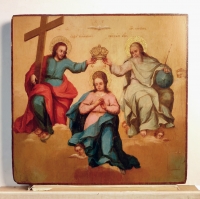

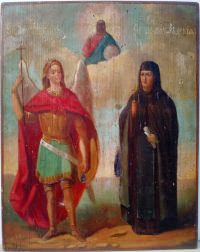
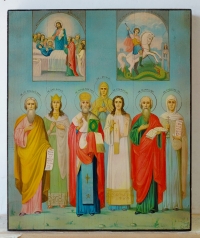
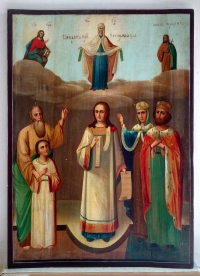
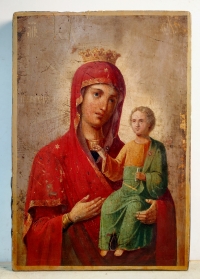
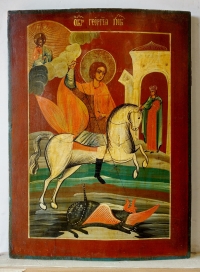

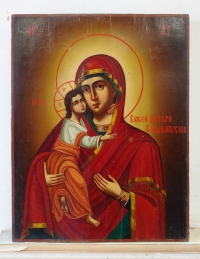
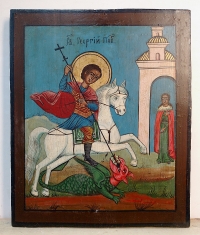
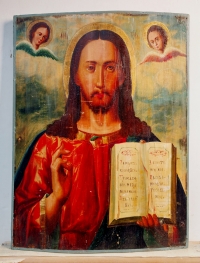
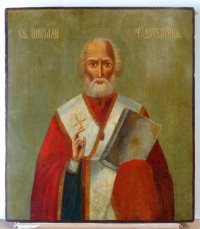
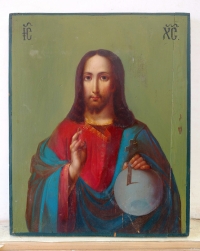
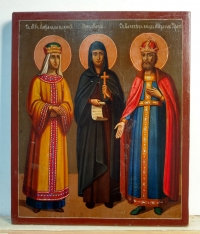
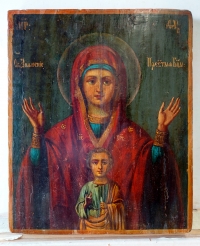

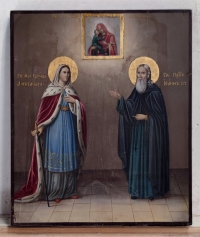

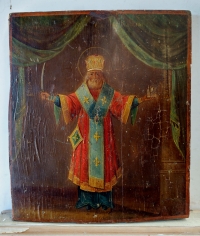
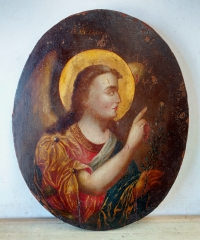
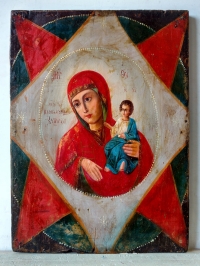
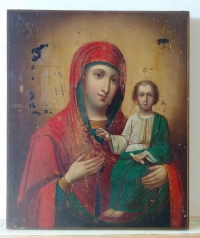

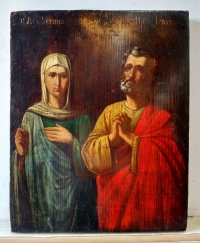
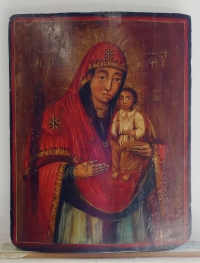

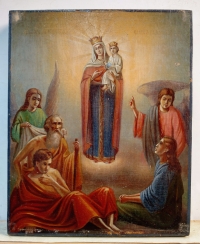
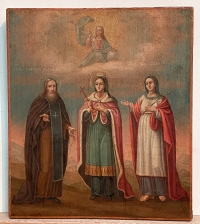
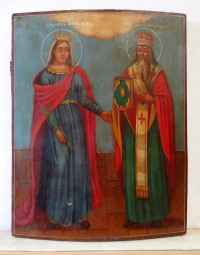
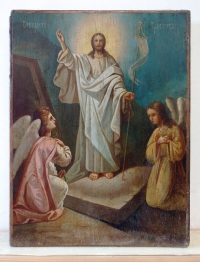



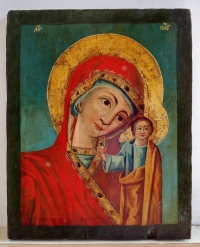


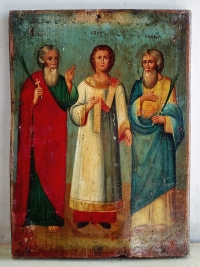
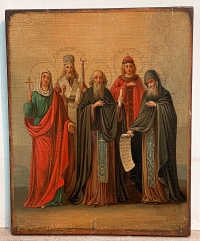
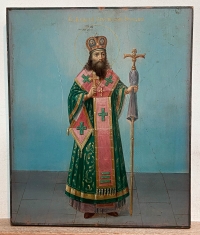
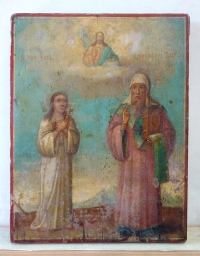
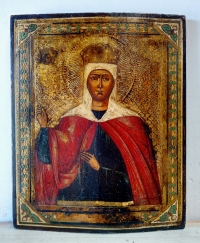

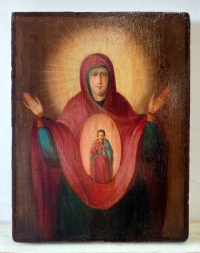
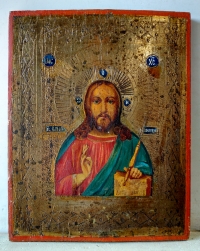
 Поменять язык на русский
Поменять язык на русский 